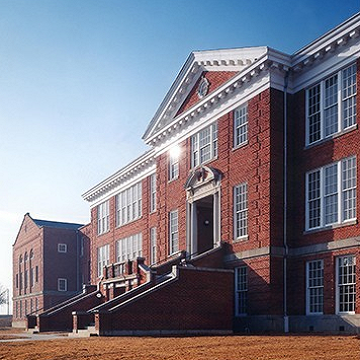GENERAL INFORMATION: Maury Commons is the adaptive reuse of the historic Maury School into a private condominium residence in downtown Fredericksburg. The project consists of 32 luxury residential condominiums as well as one office condo. This office condominium (4,414 sf) is owned by the City of Fredericksburg in an effort to preserve public space in the historic school; the space is currently occupied by the Central Rappahannock Heritage Center. The adaptive conversion of the Maury School has been since lauded by the local press, community leaders, and local preservationists.
ARCHITECTURAL FEATURES: The Maury School originally consisted of the L-shaped three-story brick building and the adjacent 1935 stadium whose concrete bleachers are centered on the school’s historic entry. The school and stadium are diagonally sited on a 7.4 acre lot that is delineated by the angled urban streets at its edge, by a row of mature evergreen and oak trees, and by a recently erected metal fence. The Colonial Revival style school building is comprised of three matching blocks that together enclose 65,000 square feet of space. The original building opened in 1920 as Fredericksburg High School to serve 7th through 12th grade students. An auditorium and gymnasium addition in the same style was centered on the north elevation in 1930. An elementary school building constructed in 1937 echoes the original building’s footprint, massing, and details, and is linked to the west end of the high school by an arcaded hyphen. The whole is a carefully unified composition; a classic example of an early-twentieth century public school. The design was originated by well-known Fredericksburg architect Philip Nathaniel Stern (1878-1960), who was also architect for many of the buildings at what is now the University of Mary Washington, as well as commercial buildings, a hospital and private homes in the city. Historian and writer Jack D. Warren, Jr. calls Maury School “the best example of institutional Colonial Revival architecture in Fredericksburg.” The stadium and its three non-contributing buildings, (press box, ticket booth, and equipment shed), are owned and operated by the City of Fredericksburg.
HISTORY/SIGNIFICANCE: Built in 1919, the Maury School was the iconic public high school for the area for sixty years, serving as both school and host to events such as football games, track meets, dances, graduations, and the historic Fredericksburg Dog Mart, a tradition dating back to annual trading exchanges between area settlers and the local Pamunkey Indian tribe. This structure was abandoned and was a blighting influence on the neighborhood for over 26 years.
The Maury School was eligible for listing on the Virginia Landmarks Register and the National Register of Historic Places under Criterion A (Education and Social History) and C (Architecture), with a Period of Significance of 1919-1956. Prominently sited next to downtown Fredericksburg, the building served the city as a public school from the time of its construction in 1920 until 1980. Maury Stadium continues to serve the community for outdoor events and high school football games. The Maury School was Fredericksburg’s first purpose-built public high school and it served as a public school for sixty years. The school was built within the bounds of Liberty Town, an African-American settlement created in the immediate aftermath of the Civil War. The Maury School occupied a central place in the community life of Fredericksburg. In addition to the educational functions of the school, the stadium was the largest public gathering place in Fredericksburg, and served many community functions. In addition to sporting events, the stadium was home to Fredericksburg’s Dog Mart, an annual dog show that drew as many as 15,000 people to the school, and was rooted in a trading agreement between the settlement that became Fredericksburg and the Pamunkey tribe of King William County. The Maury School also is a classic example of early-twentieth-century public school architecture, with high quality craftsmanship and design. In addition, the school represents the work of a significant architect, Phillip Nathaniel Stern, who designed many other prominent Fredericksburg buildings. On the exterior, the structure retains a high degree of integrity, including height, mass, materials, roof form, and significant original details such as the distinctive entrance porticos, the cast-concrete sills and corner blocks, Flemish bond and diapered brickwork, wood cornice, and banked windows. The stadium and football field are on axis with the main entry. On the interior, the structure retains integrity of design, location and configuration of circulation, floor-to-ceiling heights, wainscoting along corridors, windows, and the spaces and volumes of corridors, stairs, classrooms, principal’s office, library, gymnasium, and auditorium. Located outside of the local historic district, the property was individually listed on the National Register of Historic Places, and utilized state historic rehabilitation tax credits.







